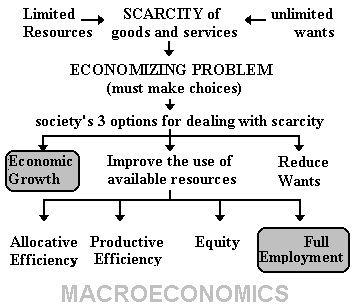 |
We are now beginning Unit 2 which is our first true introduction to MACROECONOMICS .
Introduction
What is Macroeconomics
We have defined economics as the study of how we choose to use limited resources to obtain the maximum satisfaction of unlimited human wants.
We have used our 5Es model to better understand what this definition implies. There are five ways for a society to reduce the effects of scarcity. (Actually there are six if we include "reducing wants".) The study of macroeconomics focuses on two of these: Economic Growth and Full Employment.
To these issues we will add price stability (low inflation). So the issues discussed in macroeconomics are:
1. full employment,
2. price stability, and
3. economic growth
Governments in market economies often employ policies to help the economy achieve these goals. Some of these policies involve government spending and taxation. People often complain about government spending and taxes, but it is surprising how little they actually know about them.
Therefore, as we begin our study of macroeconomics, I think we first understand the basic facts of government spending and taxation. You do not have to memorize all the data, but you do need to know the simple structure: what are the main sources of government revenues and and what are the main government expenditures categories? We'll analyze government finance by looking at each level of government in the United States: the federal government (Washington DC), state government, and local governments.
Federal Government Finance
Study the following figures to learn the primary sources of federal government revenues and where the money is spent.
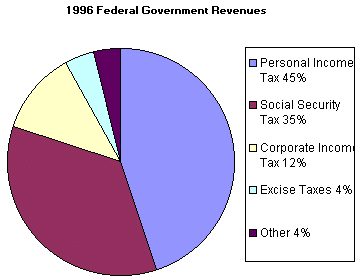
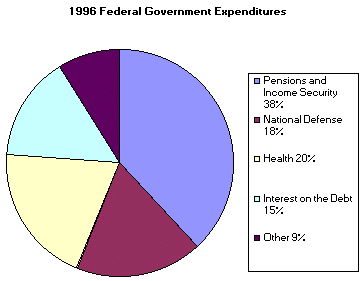
Federal Tax Revenue Sources:1. personal income tax
2. social security taxes
3. corporate income tax
4. excise taxesFederal Government Expenditures:
1. pensions and income security (includes welfare and social security)
2. national defense
3. health
4. interest on the public debt
5. otherComments:
Which of the taxes you pay go to Washington? - NOT sales taxes, NOT property taxes.
On what does the federal government spent money? - Not education. Actually, after Social Security, welfare, defense, health care, and interest on the debt, only nine percent (9%) is left for the issues that many people are talking about (education, the environment, energy, etc.).
State Government Finance
Study the following figures to learn the primary sources of state government revenues and where the money is spent.
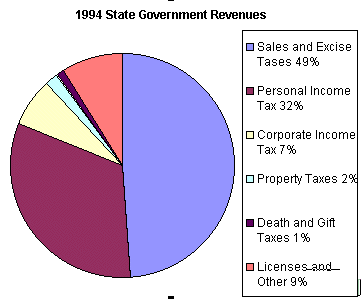
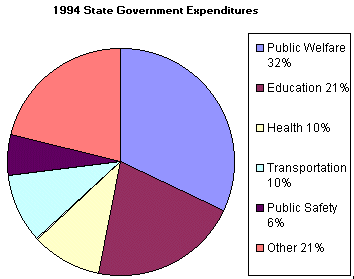
State Tax Revenues Sources:1. Sales taxes
2. Excise taxes
3. Income taxes
4. Business taxesState Government Expenditures:
1. Education
2. Welfare
3. Health
4. TransportationComments:
Note that property taxes are NOT state taxes for almost all states.
Local Government Finance
Local governments include counties, cities, townships, school districts, park districts, library districts, etc. Illinois has a large number of these local government bodies that have the authority to collect taxes. Study the following figures to learn the primary sources of state government revenues and where the money is spent.
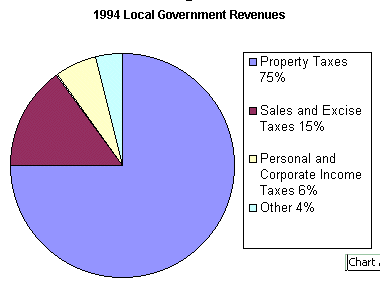
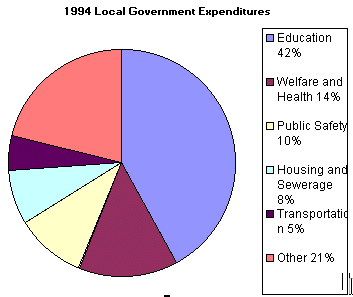
Local Tax Revenues Sources1. Property taxes
2. Sales and Excise taxesLocal Government Expenditures
1. Education
2. Health and WelfareComments:
Note that local governments rely mostly on property taxes to fund their programs. Most local governments ARE school districts, so it shouldn't surprise us that education is the largest expenditure category.
Personal Income Tax
Since the main source of federal government revenues is the personal income tax, and since many people misunderstand the federal income tax rates, and since these are sometimes used as part of a macroeconomic policy to lower unemployment (UE) or to lower inflation (IN), I think we should spend a little time studying them.
Tax Rates
In 2000 the federal income tax rates were:
15%
28%
31%
36%
39.6%
BUT, whenever you see "%", you must ask "percent of what?"
First, it is percent of "taxable income" Taxable income is your income MINUS deductions. In the discussion that follows, the word "income" will mean "taxable income", but keep in mind that your taxable income can be quite a bit less than your total income.
These tax rates are "marginal tax rates", NOT "average tax rates" Most students, and many politicians often confuse the two.
An average tax rate is the percent of your income that you pay in taxes. To calculate the average tax rate you divide the amount you pay in taxes by your income;
|
taxes paid |
||
|
average tax rate = |
|
x 100 |
|
total income |
The marginal tax rate, which is what is used on our income taxes, is the percent of ADDITIONAL income that you pay in taxes ("marginal" means "additional" or "extra").
|
additional taxes paid |
||
|
marginal tax rate = |
|
x 100 |
|
additional income |
This is important. Look at the 2000 Federal Income Tax schedule for a single person.
|
Schedule X -- Use if your filing status is Single |
||||
|
If the amount on |
|
|
of the |
|
|
|
||||
|
$0 |
$26,250 |
......... |
15% |
$0 |
So, if your (taxable) income is $26,250 you pay 15% in taxes or $3,937.50 (.15 x $26,250 = $3,937.50) or you are paying 15% of your income (taxable income) in taxes. BUT, if you receive a $1000 dollar raise, your income is now $27,250 and you are in the 28% tax bracket. If this 28% was an average tax rate, then you would have to pay .28 x $27,250 = $7630. You received a $100) raise, but your taxes would go up $3692.5 ($7630 - $3,937.50). You would beg your boss NOT to give you a raise because you end up with less take-home pay than before.
BUT IT DOESN'T WORK THAT WAY, because the tax rates are MARGINAL tax rates and they only apply to ADDITIONAL income. So you pay 15 % of the first $26,250 (= $3,937.50) and 28% of the additional $1000 (= $280). So if your income is $27,250, you will pay $4142.50 in taxes ($3,862.50 + $280 = $4217.50).
So, if your income is $27,250, you are in the 28% tax bracket, but what is your average tax rate? What percent of your total income are you paying in taxes? See the formula above: Average tax rate = taxes paid divided by total income. so if your income is $27,250 your average tax rate is $4142.50 / $27,250 = 15.2 %. You are in the 28% tax bracket, but you are paying 15.2% of your income in taxes. Actually, you are paying a lot less than 15.2% of your total income in taxes since the tax rates apply only to your taxable income.
PROBLEM: Use the table above to calculate the taxes that you would have to pay if your taxable income was $73,550 Also, calculate the marginal tax rate and the average tax rate (answers).
Government Growth
What has happened to the SIZE of government? Many people argue that the government is getting bigger. How would we know? How would we measure the size of government?
One way would be to compare how many laws and regulations that the government makes in a year. I think that if we used that as the measure the government is probably getting bigger.
Another measure could be the number of governmental employees compared to nongovernmental employees. "The ratio of civilian governmental employees per 1000 population has actually dropped from a peak of 16.5/1000 in 1952 to 11/1000 in 1995." (http://www.harding.edu/USER/lklein/WWW/KWTEST3CPA.HTM)
A popular measure of the size of government is the amount that they spend. See the graph below:
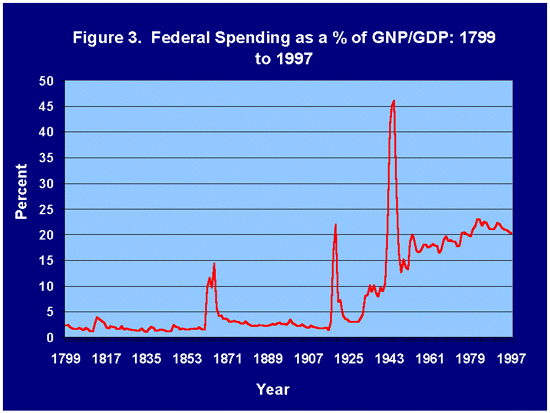
But if you examine the table below you will see that most of the increase in government expenditures occurred in Social Security, Medicare, and other medical care.
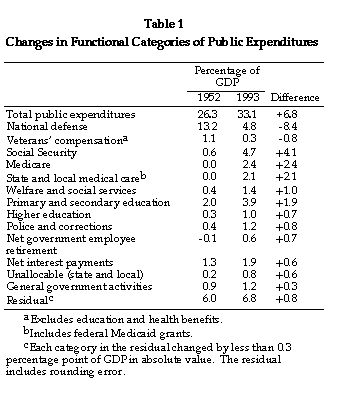
From: http://www.rand.org/publications/RB/RB2500/rb2500.html
Expenditures such as these are called "transfer payments"
because the government is NOT BUYING ANYTHING, but simply
transferring money from the taxpayers to certain groups of
recipients. If we want to see how the size of government affects
SCARCITY we should exclude such transfer payments because the
government is not using up any resources. See table below.
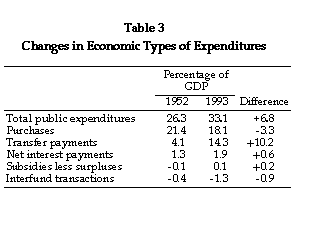
From: http://www.rand.org/publications/RB/RB2500/rb2500.html
The government purchases about 20% of what is produced in the country and this has stayed about the same since World War II.
Is the government getting bigger? -- NOT as a user of our limited resources.
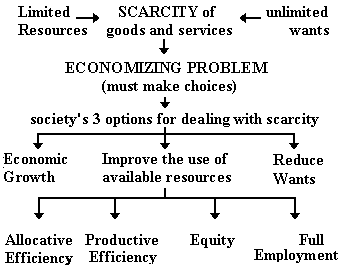
END OF LECTURE
Your calculations: $17,481.50
IRS table: $ 17,489 ( See: 10311g83.gif)
Marginal tax rate: 31%
Average tax rate = $17,489 / $73,550 = 23.8%
HOW TO GET THE ANSWER:
PROBLEM: Use the table above to calculate the taxes that you would have to pay if your taxable income was $72,450. Also, calculate the marginal tax rate and the average tax rate (answers).
How to calculate:
Your income is $73,550
You pay 15% of the first $26,250 or .15 x $26,250 =
$3937.50
You pay 28 % on income between $26,250 and $63,550 or .28 x
$37,300 = $10,444.00
You pay 31% on income over $63,550 or .31 x $10,000 =
$3100.00
Now add:
|
$3,937.50 |
OR according to the tax schedule "If the amount on Form 1040, line 39, is: Over $63550, but not over $132,600 Enter on Form 140 Line 40 $14,381.50 + 31% of the amount over $63,550", so you add 14,381 + 3100 to get $17,481
Since your income is $73,550, it is more than $63,550, but not
over $132,600.
Therefore, you can see from the tax schedule below you are in the 31%
tax bracket. This is your marginal tax rate.
Tax Schedule:
|
Schedule X -- Use if your filing status is Single |
||||
|
If the amount on |
|
|
of the |
|
|
|
||||
|
$0 |
$26,250 |
......... |
15% |
$0 |
An average tax rate is the percent of your income that you pay in taxes To calculate the average tax rate you divide the amount you pay in taxes by your income;
|
taxes paid |
||
|
average tax rate = |
|
x 100 |
|
total income |
Therefore,
|
$17,481.50 |
||
|
average tax rate = |
|
x 100 |
|
$73,550 |
average tax rate = 23.8%
[back]